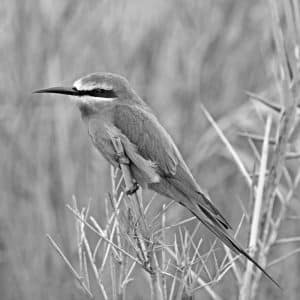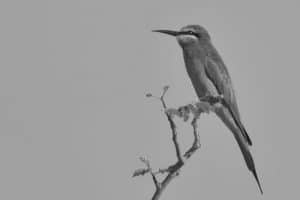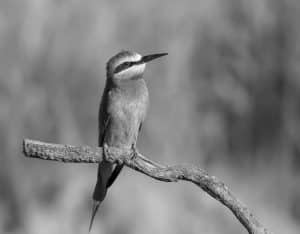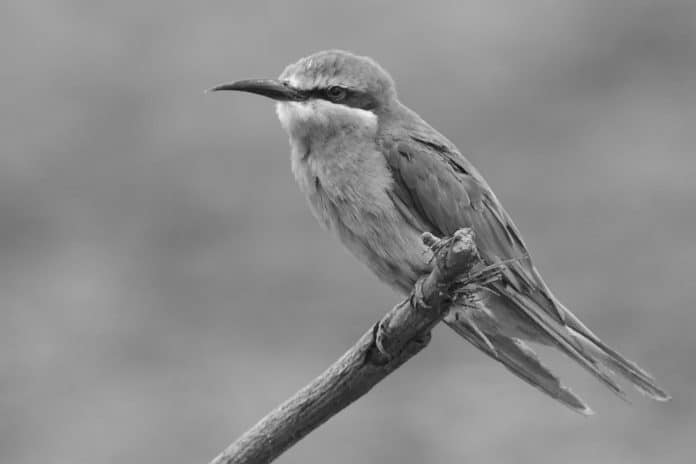Introduction to the Blue-Cheeked Bee-Eater
Welcome to the world of the Blue-Cheeked Bee-Eater, a stunningly beautiful bird that graces the Tanzanian grasslands with its azure splendor. The Blue-Cheeked Bee-Eater in Tanzania, scientifically known as Merops persicus, is a member of the bee-eater family, characterized by its vibrant plumage and graceful aerial acrobatics. These elegant birds are a sight to behold as they swoop and glide through the open skies, showcasing their remarkable agility and precision. In this article, we will delve into the fascinating world of the Blue-Cheeked Bee-Eater, exploring its habitat, behavior, cultural significance, and the best locations for birdwatching and photographing these magnificent creatures in Tanzania.
Habitat and Distribution of the Blue-Cheeked Bee-Eater in Tanzania

The Blue-Cheeked Bee-Eater is native to a wide range of habitats across Africa and Asia, including Tanzania. Within Tanzania, these birds are commonly found in savannas, grasslands, and open woodlands, where they can thrive due to the abundance of insect prey and suitable nesting sites. The country’s diverse landscape provides the perfect environment for these birds to breed and raise their young, making it a prime destination for birdwatchers and wildlife enthusiasts.
The distribution of the Blue-Cheeked Bee-Eater in Tanzania is widespread, with populations being observed in various regions, including the Serengeti, Tarangire, and Ruaha National Parks. These protected areas offer critical habitat for the bee-eaters, allowing them to carry out their natural behaviors and contribute to the ecological balance of the ecosystem. As such, conservation efforts in these areas play a crucial role in safeguarding the future of the Blue-Cheeked Bee-Eater in Tanzania.
Physical Characteristics and Behavior of the Blue-Cheeked Bee-Eater
The Blue-Cheeked Bee-Eater is renowned for its striking appearance, featuring a combination of vibrant colors that make it a standout species in the avian world. The bird’s most distinctive features include its deep blue crown, green mantle, and, as the name suggests, the striking blue cheek patches that adorn its face. These bold colors are complemented by a chestnut throat and a long, slender black beak, creating a visually stunning ensemble that captivates all who have the privilege of witnessing it in the wild.
In addition to its captivating appearance, the Blue-Cheeked Bee-Eater is also known for its remarkable behavior and feeding habits. As its name implies, the bird primarily feeds on bees and other flying insects, which it catches on the wing using its agile flight skills. The bee-eater’s aerial prowess is a sight to behold, as it performs acrobatic maneuvers to snatch its prey from the air with remarkable precision. Furthermore, these birds are highly social and can often be observed in small flocks, engaging in cooperative hunting and vocal communication, adding to the allure of observing them in their natural environment.
Breeding and Nesting Habits of the Blue-Cheeked Bee-Eater
During the breeding season, which typically occurs between March and July, the Blue-Cheeked Bee-Eater engages in intricate courtship displays and nest-building activities. The birds form monogamous pairs, with both partners participating in the construction of their nesting burrow in sandy banks or earth walls. The female bee-eater lays a clutch of eggs, usually numbering between 4 to 8, which are then incubated by both parents. This cooperative effort highlights the strong bond between the mating pair and their commitment to ensuring the survival of their offspring.
Once the eggs hatch, the parents diligently care for the chicks, bringing them a steady supply of insects to nourish and nurture them until they are ready to fledge. The sight of the vibrant adult bee-eaters tending to their young in their earthen burrows is a testament to the resilience and adaptability of these remarkable birds, as they navigate the challenges of the natural world to ensure the continuation of their species.
Conservation Status and Threats to the Blue-Cheeked Bee-Eater in Tanzania

While the Blue-Cheeked Bee-Eater is not currently considered globally threatened, it faces localized challenges and threats in certain regions, including Tanzania. Habitat destruction, agricultural expansion, and human disturbance are among the primary concerns that impact the well-being of these birds and their ability to thrive in their natural environment. As such, conservation efforts and habitat protection are essential for safeguarding the future of the Blue-Cheeked Bee-Eater in Tanzania.
In addition to anthropogenic threats, the bee-eaters also face natural predators and environmental factors that can impact their populations. By understanding the specific challenges that these birds encounter, conservationists and wildlife authorities can implement targeted strategies to mitigate these threats and ensure the long-term survival of the Blue-Cheeked Bee-Eater in Tanzania.
Best Locations for Birdwatching and Photographing Blue-Cheeked Bee-Eaters in Tanzania
Tanzania offers a wealth of opportunities for birdwatchers and wildlife photographers to observe and capture the beauty of the Blue-Cheeked Bee-Eater in its natural habitat. National parks and conservation areas such as the Serengeti, Tarangire, and Ruaha are renowned for their diverse birdlife, including the presence of these stunning bee-eaters. The open grasslands and woodlands provide ideal settings for spotting these birds as they forage, nest, and engage in their captivating behaviors.
For those seeking an immersive birdwatching experience, guided safaris and tours led by knowledgeable local experts offer the chance to explore the prime bee-eater habitats and observe these birds in their element. The expertise of experienced guides can enhance the birdwatching experience, providing valuable insights and opportunities to witness the Blue-Cheeked Bee-Eater’s behavior and interactions up close.
Tips for Birdwatching and Photographing Blue-Cheeked Bee-Eaters
When embarking on a birdwatching or photography expedition to observe the Blue-Cheeked Bee-Eater in Tanzania, there are several tips and considerations to enhance the experience and maximize the chances of encountering these magnificent birds. Firstly, it is essential to research the optimal times of year for bee-eater sightings, taking into account the breeding season and migratory patterns to increase the likelihood of observing them in their full splendor.
Additionally, investing in quality binoculars and camera equipment can greatly enhance the ability to spot and capture the intricate details of the bee-eaters’ plumage and behavior. Patience and attentiveness are also key virtues when engaging in birdwatching, as the ability to remain still and observant increases the chances of witnessing the captivating aerial displays and interactions of the Blue-Cheeked Bee-Eater.
Cultural Significance of the Blue-Cheeked Bee-Eater in Tanzania

In Tanzanian culture, the Blue-Cheeked Bee-Eater holds symbolic significance and is revered for its beauty and grace. The vibrant colors and elegant flight of these birds have inspired local folklore and artistic expressions, with the bee-eater often depicted in traditional stories, songs, and visual arts as a symbol of vitality, harmony, and natural beauty.
Furthermore, the presence of the Blue-Cheeked Bee-Eater in the Tanzanian landscape serves as a reminder of the country’s rich biodiversity and the interconnectedness of all living beings within the ecosystem. As such, these birds are not only a source of wonder and admiration for their aesthetic appeal but also a reflection of the intricate balance of nature that is cherished and celebrated in Tanzanian traditions.
Conclusion
The Blue-Cheeked Bee-Eater stands as a testament to the resplendent beauty and ecological significance of Tanzania’s avian inhabitants. With its azure splendor and graceful presence, this remarkable bird enriches the Tanzanian grasslands and captivates the hearts of all who have the privilege of encountering it in the wild. Through conservation efforts, responsible tourism, and a deep appreciation for its cultural significance, the Blue-Cheeked Bee-Eater can continue to thrive and inspire generations to come, ensuring that its azure splendor remains a cherished emblem of Tanzania’s natural heritage.


































